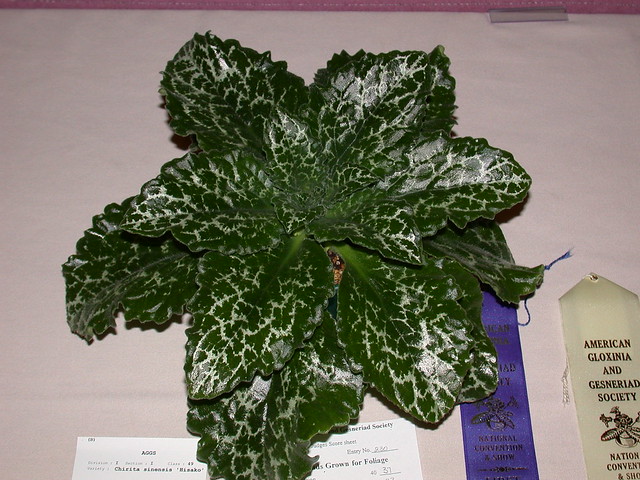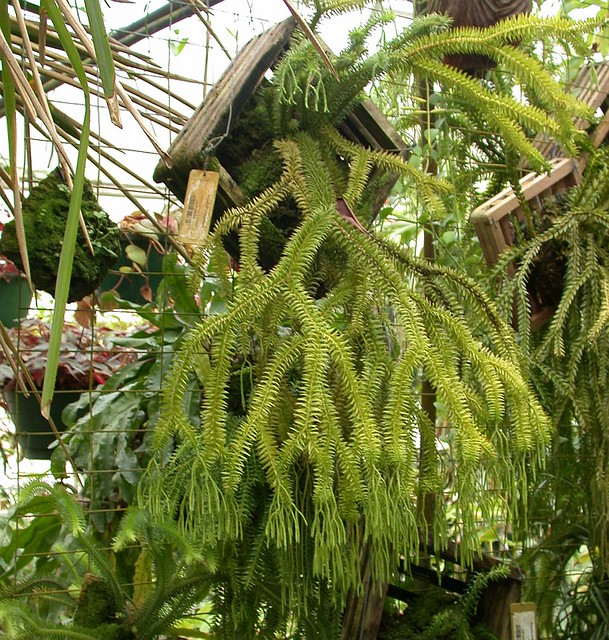
What's the botanical name of this tassel fern?
While preparing a blog post about the United States Botanic Garden, I had a bit of a quandary with an interesting plant I photographed there. The plant is sometime known as "tassel fern", but I had forgotten to note its botanical name so I posted it on my Facebook page and shared it with a few fern groups to get the proper identification. What I got back were 3 different names: Lycopodium squarrosum, Huperzia squarrosa, and Phlegmariurus squarrosus. Which one is right?

Lycopodium squarrosum, Huperzia squarrosa, or Phlegariurus squarrosus? (Selaginella kraussiana is the smaller plant growing beneath it)
Well, it depends on how you define "right". When discussing botanical names, people (including some who should know better) often throw around words like valid, legitimate, correct, or accepted. These terms are frequently misunderstood, misused, and confused with each other, but they mean different things. The first three terms—valid, legitimate, and correct—are matters of nomenclature and have to do with purely objective matters like whether the name was properly published under the rules, was provided with an adequate description, that the same name had never been used for something different, that the oldest available name is used, and that the name used is consistent with the taxonomy of the group under consideration. These terms have precise meanings under the International Code of Botanical Nomenclature, the rules that botanists have agreed upon to govern the botanical naming of plants. The last term—accepted—does not, because what is "accepted" is a matter of taxonomy and not of nomenclature. If you just want to know which is the right taxonomic name of the plant, skip over the next 3 or 4 paragraphs that deal with a bit of taxonomic backstory that I realize not everybody will find as fascinating as I do.
"Tassel ferns" aren't ferns at all, belonging rather to an ancient group of plants known as lycopods or clubmosses. This group has been subject to quite a bit of taxonomic rearrangement in recent years but when I was first learning about plant classification 40-some years ago, the field guides and non-technical references placed all of the living clubmosses in a single genus, Lycopodium. This followed the lead of Linnaeus, who knew of only about two dozen species, mostly European, in 1753. He used the already-established name Lycopodium (literally, "wolf's foot") and classified them as mosses. As more species were discovered, particularly in the tropics, it became evident that this was a rather large and diverse group. In 1801, German botanist Johann Jakob Bernhardi decided that the species that produce sporangia in their leaf axils (rather than in "clubs") were different enough from the rest to merit their own separate genus, Huperzia, naming it in honor of German doctor Johann Peter Huperz, an amateur botanist who had published a well-regarded work on fern propagation.
Unfortunately, Bernhardi never said precisely which Lycopodium species should be included in his new genus and it was mostly ignored until the 1870's, when Italian botanist Vittore Benedetto Antonio Trevisan de Saint-Léon agreed with him and transferred numerous Lycopodium species into Huperzia. Alas, Trevisan was also largely ignored and most botanists continued to lump everything into the single genus Lycopodium.
Not until the 1940's, with the work of German botanist Werner Walter Hugo Paul Rothmaler, did Huperzia begin to make some headway and from the 1950's to 1970's this genus became more widely used and recognized. Around the same time, Czech botanist Josef Holub began to split up the remainder of Lycopodium, creating additional new genera like Lycopodiella and Diphasiastrum. Even Huperzia proved to be a bit problematic, and in 1964 Holub created the new genus Phlegmariurus for a group of former Huperzia species that are primarily tropical and primarily epiphytic. The remaining Huperzia species are primarily temperate and terrestrial, like Huperzia lucidula (which I knew as Lycopodium lucidulum when I was growing up in western New York).
Many field guides still listed all of these species under the broadly defined genus Lycopodium into the 1990's but more and more botanists jumped on board with the new classifications and they are now widely accepted. Without going into too much detail, new molecular data and new ways of investigating and expressing relationships largely supported the classifications that recognized several smaller and better-defined genera in Lycopodiaceae. The botanists aren't finished yet; in 2003, Arthur Haines carved a few more species out of the already much-reduced Lycopodium to create yet another new genus, Spinulum. It remains to be seen how widely accepted this new genus will be.
Are you still with me? In a nutshell, the name of this species has gone from Lycopodium squarrosum to Huperzia squarrosa, then back to Lycopodium, back to Huperzia, back to Lycopodium, back to Huperzia, and finally to Phlegmariurus, with some holdouts for Huperzia. (There was a brief side trip to Urostachys somewhere in there, but that's another story entirely.) So... which name is right?
All of them. In terms of botanical nomenclature, none of these names (well, except Urostachys; again, another story) is wrong. They are all valid, they are all legitimate, and they are all correct* within their respective classification schemes. Which of these classifications to follow is another matter entirely. What you really want to know is, which name is accepted? That's a little trickier because classifications are opinions, and therefore subjective. Different taxonomists will have different opinions about the best way to classify a group, and these opinions change over time as new evidence is discovered and old evidence re-interpreted. It was the opinion of Linnaeus that all these things be treated under a single genus, Lycopodium, and that wasn't such a bad opinion: they are all certainly related to each other, and more closely than to any other groups of plants. It's the opinion of many current botanists that a more finely divided classification is better. But if you accept Lycopodium in its original broad sense (and some botanists still do), then Lycopodium squarrosum is the correct name. If you accept that Phlegmariurus should be included in Huperzia, then Huperzia squarrosa is quite correct. And if you accept the genus Phlegmariurus, then Phlegmariurus squarrosus is correct.
Huperzia (Phlegmariurus) sp., Marie Selby Botanical Gardens
This taxonomic mess represents just a tiny fraction of what's going on in plant classification in recent years and many of us are just waiting for the dust to settle. It will never settle entirely because plant systematics is a dynamic field, but right now we're in a particularly unsettled time of changing classifications. Newly proposed classifications are accepted or rejected based on consensus, but sometimes a clear consensus doesn't immediately emerge, resulting in two (or more) alternate classifications—all of them perfectly valid—for the same group. This is the case with Huperzia and Phlegmariurus. You will see both names, Huperzia squarrosa and Phlegmariurus squarrosus, and they are both absolutely acceptable. Heck, even Lycopodium squarrosum, now considered a bit old-fashioned and outdated, is still a perfectly good name. And you know something? There won't be anybody coming to beat down your door and make you use one of the other names. Use whichever one you're most comfortable with, and don't apologize for it.
If any of this isn't clear, or you think I've just muddled things more, please let me know in the comments!

Chirita sinensis or Primulina dryas? Both names are "right"!
*In some cases the "correct" name may be very different depending on generic placement. During a recent reorganization in Old World Gesneriaceae the name Chirita sinensis—a relatively well-known gesneriad species—could not transferred to the genus Primulina because there was already a Primulina sinensis blocking it. In this case, the next oldest name, Chirita dryas, was available and the species became Primulina dryas. Both names are perfectly correct, depending on whether you place this species in Chirita or Primulina. "Chirita dryas" would be incorrect because the name Chirita sinensis is earlier and has nomenclatural priority. "Primulina sinensis" would be incorrect because that name had already been used for something different.


Sometimes it's the common names that cause the most trouble. My mother asks me for the name whenever I give her a new plant, and if I throw any Latin at her (in botanical names) she always makes a face and asks "but what do normal people call it?"
ReplyDeleteThe accepted name is Huperzia squarrosa (G. Forst.) Trevis.
ReplyDeleteLycopodium squarrosum G. Forst. is a synonym. Try to look there:
http://www.theplantlist.org/tpl1.1/record/tro-26601818
You seem to have missed the entire point of this blog post. The Plant List represents one particular classification and one particular point of view. It does not have any authority to say one name must be used over the other. "Accepted" should always be followed by (although sometimes only implied) "according to..."
Delete